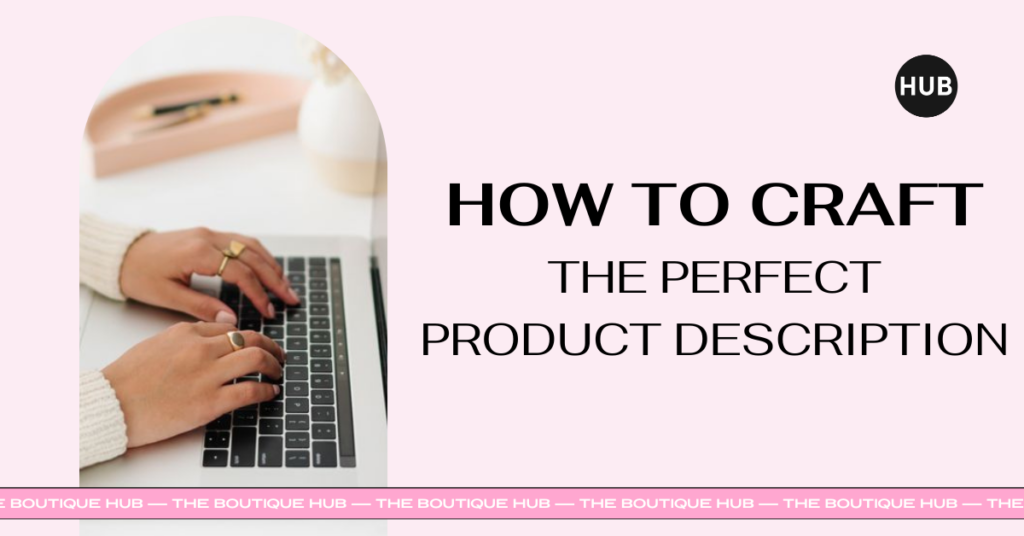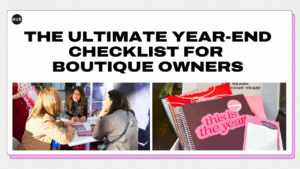In the world of e-commerce, your product descriptions play a pivotal role in enticing potential customers and driving sales. A well-crafted product description can paint a vivid picture, answer questions, and address concerns, ultimately persuading shoppers to make a purchase. If you’re a small business owner looking to improve your product descriptions, you’re in the right place. In this blog post, we’ll explore the art of writing the perfect product description that captivates your audience and sets your boutique apart.

- Know Your Audience
Before you start writing, it’s crucial to understand your target audience. Consider their demographics, interests, and pain points. Tailoring your product descriptions to resonate with your ideal customers will make them more relatable and appealing. Speak their language, address their needs, and showcase how your product can enhance their lives.
- Highlight Unique Selling Points
What makes your product stand out? Identify its unique selling points (USPs) and emphasize them in your description. Whether it’s exceptional quality, sustainable materials, or exclusive designs, make sure these features are front and center. Explain how these aspects benefit the customer and set your product apart from the competition.
- Be Clear and Concise
Avoid vague or overly technical language. Keep your product descriptions clear, concise, and easy to understand. Use simple sentences and bullet points when necessary to break down information into digestible chunks. Shoppers should quickly grasp what your product is, what it does, and why they need it.
- Create an Emotional Connection
Effective product descriptions go beyond the features and benefits; they create an emotional connection with the reader. Use storytelling techniques to evoke feelings and paint a vivid picture of how your product fits into their lives. Share relatable scenarios, and highlight the emotions or experiences your product can evoke. What events can your customer wear this item too? Where in her home can she use this decor item? Use your product description to tell a story.
- Provide Detailed Specifications
While brevity is essential, it’s equally crucial to provide comprehensive product details. Include essential information such as size, color options, materials, care instructions, and any other relevant specifications. This helps customers make informed decisions and reduces the likelihood of returns or dissatisfaction.
- Use High-Quality Images
Complement your product descriptions with high-quality images. Visuals play a significant role in the online shopping experience. Include multiple images showcasing different angles, close-ups, and lifestyle shots. These images should align with your description and help customers visualize the product in their lives.
- Incorporate SEO Keywords
Optimize your product descriptions for search engines by incorporating relevant keywords. Research popular search terms in your niche and seamlessly integrate them into your descriptions. However, ensure that the keywords fit naturally and don’t compromise the overall quality of your content.
- Offer Social Proof
Boost confidence in your products by including customer reviews, ratings, and testimonials within your product descriptions. Honest feedback from satisfied customers can provide valuable insights and encourage potential buyers to trust your brand.
- Call to Action (CTA)
Every product description should have a clear and compelling call to action. Encourage visitors to take the next step, whether it’s adding the product to their cart, subscribing to your newsletter, or following your boutique on social media. Use action-oriented phrases like “Shop Now,” “Discover More,” or “Add to Cart” to prompt action.
Crafting the perfect product description is an art that combines creativity and strategy. Small business owners can differentiate themselves in the competitive e-commerce landscape by creating compelling, informative, and emotionally resonant descriptions. Remember to know your audience, highlight your product’s unique features, provide clear specifications, and use images and SEO effectively. By following these guidelines, you can create product descriptions that engage, inspire, and drive sales for your boutique.
Get more information on growing your business by joining The Boutique Hub where we have tons of training, information, and most importantly, connection! Try out our service for a month, cancel anytime.
Follow along on Instagram @theboutiquehub.
- The Boutique Hub at MAGIC NYC
 The Hub Team is heading to MAGIC New York again and we couldn’t be more excited! With over 320+ brands, you are sure to find more MAGIC in a (New York) minute!
The Hub Team is heading to MAGIC New York again and we couldn’t be more excited! With over 320+ brands, you are sure to find more MAGIC in a (New York) minute! - The Boutique Hub is Heading to PGA Orlando!
 The Boutique Hub is heading to the PGA Show in Orlando. Tapping into the fast-growing golf apparel market projected to hit $13B by 2032. Golf fashion is evolving beyond the course, creating big opportunities for boutique retailers. The Hub team will be connecting with brands, discovering new trends, and offering live education and retail audits at the event on July 28th. Boutique owners interested in athleisure, activewear, or preppy styles should consider adding golf-inspired looks to their lineup. VIP perks available through The Hub’s exclusive registration link.
The Boutique Hub is heading to the PGA Show in Orlando. Tapping into the fast-growing golf apparel market projected to hit $13B by 2032. Golf fashion is evolving beyond the course, creating big opportunities for boutique retailers. The Hub team will be connecting with brands, discovering new trends, and offering live education and retail audits at the event on July 28th. Boutique owners interested in athleisure, activewear, or preppy styles should consider adding golf-inspired looks to their lineup. VIP perks available through The Hub’s exclusive registration link. - 2025 Wrapped: The Boutique Hub Community by the Numbers
 From thousands of daily conversations to millions of podcast downloads, 2025 was a powerful year for The Boutique Hub community. This recap breaks down the biggest wins, trends, and milestones—and shows how retailers can turn that momentum into a clear plan for an even stronger year ahead.
From thousands of daily conversations to millions of podcast downloads, 2025 was a powerful year for The Boutique Hub community. This recap breaks down the biggest wins, trends, and milestones—and shows how retailers can turn that momentum into a clear plan for an even stronger year ahead. - Sales Tax & Nexus Simplified
 Sales tax and nexus can feel like one giant headache — but it doesn’t have to be. If you sell across state lines, even online, you’re expected to collect and remit sales tax based on where your customers live… and those rules change constantly. Understanding when you’ve triggered nexus (and in which states) is the key to staying compliant and avoiding costly penalties. This guide breaks it all down in simple terms, so you can finally feel confident about what you owe, where you owe it, and how to stay ahead of it.
Sales tax and nexus can feel like one giant headache — but it doesn’t have to be. If you sell across state lines, even online, you’re expected to collect and remit sales tax based on where your customers live… and those rules change constantly. Understanding when you’ve triggered nexus (and in which states) is the key to staying compliant and avoiding costly penalties. This guide breaks it all down in simple terms, so you can finally feel confident about what you owe, where you owe it, and how to stay ahead of it. - The Ultimate Year-End Checklist for Boutique Owners
 We are so excited to be bringing you some tips to make rolling into 2026 the smoothest transition yet! Here you will find our Boutique Owner’s End of the Year Checklist, filled with info on taxes, inventory, and more!
We are so excited to be bringing you some tips to make rolling into 2026 the smoothest transition yet! Here you will find our Boutique Owner’s End of the Year Checklist, filled with info on taxes, inventory, and more!






